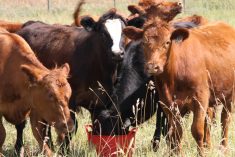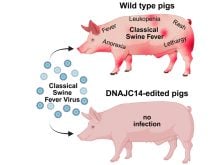RED DEER – Farm animals should receive pain relief for procedures like dehorning and castration.
After studying pain management for livestock while working in New Zealand, Joe Stookey is an advocate of relief for animals of any age subjected to painful procedures needed for their health and welfare.
“It is not age dependent on whether they feel pain or not,” he told the Alberta Farm Animal Care annual meeting in Red Deer March 23.
“The work says regardless of what age you do it, you should be using something to block pain,” he said.
Read Also

The Western Producer Livestock Report – November 6, 2025
Western Producer Livestock Report for November 6, 2025. See U.S. & Canadian hog prices, Canadian bison & lamb market data and sales insights.
Stookey works at the Western College of Veterinary Medicine at the University of Saskatchewan and took a sabbatical to study livestock practices in New Zealand, which has introduced new animal welfare laws and legally binding codes of practice. Codes apply to each of the commodity groups and there are additional rules covering transportation and painful procedures.
Under the law first passed in 1999, beak trimming in chicks, removal of deer antlers, tail docking in pigs, castration of males and dehorning may still be done if a benefit can be proven for the animal or if it reduces risk to people’s safety or improves the animal product. For example, hogs may be castrated to prevent boar taint from flavouring pork.
The new code banned tail docking of dairy cows. It was believed cutting off tails lowered the risk of leptosporosis, but scientific evidence does not bear that out for either human or animal health.
The codes also stipulate pain relief for dehorning any animal older than nine months. Castration and tail docking of animals older than six months of age requires pain relief. High tension bands require pain relief at any age.
No painful procedures are allowed on animals less than 12 hours old because scientists believe this interferes with colostrum intake and bonding with mothers.
Stookey worked at a private research centre with dairy calves to study the effects of pain relief.
The New Zealand custom is to breed dairy cows around the same time so many calves arrive simultaneously. They are sent to rearing stations and are processed in large groups. Dehorning, castration and other processes are handled on a large scale. In North America, dairy calves tend to arrive year round.
One project looked at what happens to young calves when they are debudded with and without an anesthetic. In Canada, most are debudded without pain relief.
Eye temperature was assessed with an infrared thermography camera and heart rates were measured.
“If they are experiencing pain or suffering, you may see a drop in temperature,” Stookey said.
He also observed behaviour for three hours after procedures.
Those debudded without a pain blocker showed a rapid drop in eye temperature and an increase in heart rate for three hours after.
When the drugs were used, temperature and heart rates were unchanged from normal.
However, once the drugs wore off, the animals exhibited signs of pain so longer acting painkillers are probably needed. This is probably similar to when a person has a tooth pulled; the pain is felt later when the freezing stops.
Animals in pain may be anxious and not want to eat or ruminate. Calves may flick ears, scratch and not want to play with the others in the pen.
Lidocaine is a common pain blocker. Canadian producers can purchase it without a prescription. Prescription drugs are also available, said Duane Landals, registrar of the Alberta veterinary medical association.
Vets have a role to play in pain management and should teach people how to use these drugs and observe proper withdrawal times, said Landals.
Canadian meat quality assurance programs have restrictions that make it difficult to use these drugs.
“We should be looking at ways around that,” Landals said.















